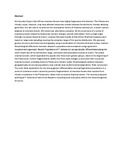The role of dispersal and vicariance in the Pleistocene history of an East African mountain rodent, Praomys delectorum

View/
Date
2013Author
Bryja, Josef
Mikula, Ondřej
Patzenhauerová, Hana
Oguge, Nicholas O
Šumbera, Radim
Verheyen, Erik
Type
ArticleLanguage
enMetadata
Show full item recordAbstract
Aim
Species living in East African montane forests have highly fragmented distributions. Plio-Pleistocene climatic cycles, however, may have allowed temporary contact between forest blocks, thereby allowing gene flow. Our aim was to reconstruct the colonization history of Praomys delectorum, a rodent species adapted to montane forests. We tested two alternative scenarios: (1) the occurrence of a series of vicariance events related to Quaternary climatic changes; and (2) colonization from a single origin through successive dispersal events.
Location
Montane forests of East Africa.
Methods
Analyses were based on large-scale sampling covering the complete range of the species distribution. We assessed genetic structure and historical demography using a combination of mitochondrial and nuclear markers. Morphological differences between allopatric populations were analysed using a geometric morphometric approach.
Results
Populations of P. delectorum are genetically differentiated along the north–south axis of the distribution range, consistent with postulated vicariance events. The oldest vicariance event, which separated the species into three main genetic groups, dates to the beginning of the Pleistocene. Further fragmentation within the three main lineages is consistent with successive vicariance events, probably linked to Pleistocene climatic cycles. Morphological variation between geographically structured populations may indicate local environmental adaptations.
Main conclusions
The most likely explanation for the strong genetic differentiation among fragmented populations is a series of vicariance events caused by periodic fragmentation of montane forests that resulted from climatic oscillations in the Pleistocene, rather than successive dispersal events. The recently proposed splitting of P. delectorum into three allopatric morphospecies only partly reflects the observed genetic structure.
Citation
Journal of Biogeography Volume 41, Issue 1, pages 196–208, January 2014Publisher
University of Nairobi
